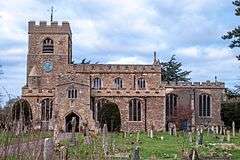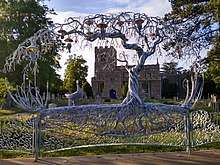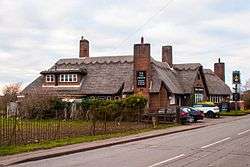Girton, Cambridgeshire
Girton is a village and civil parish of about 1,600 households, and 4,500 people in Cambridgeshire, England. It lies about 2 miles (3.2 km) to the northwest of Cambridge, and is the home of Girton College, a constituent college of the University of Cambridge.
| Girton | |
|---|---|
 St Andrew's Church in February 2017 | |
 Girton Location within Cambridgeshire | |
| Population | 4,559 (2011)[1] |
| OS grid reference | TL422615 |
| District | |
| Shire county | |
| Region | |
| Country | England |
| Sovereign state | United Kingdom |
| Post town | Cambridge |
| Postcode district | CB3 |
| Dialling code | 01223 |
| Police | Cambridgeshire |
| Fire | Cambridgeshire |
| Ambulance | East of England |
| UK Parliament | |
| Website | www.girton-cambs.org.uk |
Listed as Grittune in around 1060 and Grittune in the Domesday Book, the village's name is derived from the Old English grēot + tūn meaning "farmstead or village on gravelly ground", as the settlement was formed on a gravel ridge.[2]
History
Girton has a long history, and has been home to a poor settlement for more than 2000 years. The parish lies on the Via Devana, the Roman road, and a cemetery with at least 225 burials between the second century AD and the early Anglo Saxon period was found near to Girton College in 1880. In addition, traces of agriculture from the late Bronze Age and Roman period were found to the north of the village in 1975. A selection of Anglo-Saxon items are stored in the collection of Girton College.[3]
Church

The parish church has been dedicated to Saint Andrew since at least 1240. Part of the west tower contains stones that were probably part of an earlier 11th-century church on the site, and there are parts of 13th century construction still in evidence, but the present building was largely rebuilt in the 15th and 16th centuries.[3] The church was owned by Ramsey Abbey from the 12th century until the Dissolution of the Monasteries.
Ellen Wordsworth Darwin née Crofts, the second wife of Sir Francis Darwin is buried in the churchyard of St. Andrew's Church.
A Baptist church was built in the village in 1860.[3]
Village sign
The current village sign, situated on the corner of Redgate Road and Cambridge Road was erected in 1985 after a fund-raising campaign.
Designed by Denis Cheason and made by Barry Sharman, the design is formed from a number of separate images. The top part of design is based on a Roman belt discovered in a burial ground near Girton College. The centre is derived from the family coat of arms of Anne-Maria Cotton, who endowed the first Girton village school, together with geese, kept at Washpit, that provided quills for use in the University of Cambridge. The flowers near the village's name are corn marigolds which were once common in the village, and at the base is the cross of Saint Andrew to whom the parish church is dedicated.It is the terminus of the M11 motorway.It also has the Girton Interchange.[4]
Village life

Girton has three public houses; the Old Crown opened in around 1840, The George (formerly the George and Dragon) which was opened by a blacksmith in the 1850s, and The Traveller's Rest a modern addition on Huntingdon Road on the outskirts of Cambridge. The village's first pub, the White Horse, was opened in around 1760 but closed in the late 20th century.[3] The village hosts a rare variant of the grey squirrel — the black squirrel.[5]
Education
Girton College, a constituent college of the University of Cambridge, is situated within the village. Formed in 1869 under the name of the College for Women at Benslow House, it was originally based in Hitchin, before moving to its current site in 1873, at which time it took its current name. Until 1976 it admitted only women.
The village also contains a primary school, Girton Glebe. Built in 1951, it replaced the village's original school, built in 1845,[6] as well as Gretton School, a special school for pupils with autism spectrum disorders.[7]
People from Girton
- Emma Turner (1866-1940) ornithologist and pioneering bird photographer[8]
- Vic Watson (1897-1988) West Ham United's record goal scorer
References
- "Civil Parish population 2011". Neighbourhood Statistics. Office for National Statistics. Retrieved 17 July 2016.
- A. D. Mills, A Dictionary of British Place-Names (2003)
- A. P. M. Wright & C. P. Lewis (eds.) (1989). A History of the County of Cambridge and the Isle of Ely: Volume 9: Chesterton, Northstowe, and Papworth Hundreds. pp. 115–118.CS1 maint: extra text: authors list (link)
- "Girton village website".
- Black Squirrels Archived 2011-06-06 at the Wayback Machine
- A. P. M. Wright & C. P. Lewis, ed. (1989). A History of the County of Cambridge and the Isle of Ely: Volume 9: Chesterton, Northstowe, and Papworth Hundreds. pp. 128–129. Retrieved 16 May 2017.
- "School and residential report: Gretton School" (PDF). Ofsted. 12–14 November 2013. Retrieved 7 November 2017.
- H-W, A. (January 1941). "Miss Emma Louise Turner". Ibis. 83 (1): 188–189. doi:10.1111/j.1474-919X.1941.tb00609.x.
External links
| Wikimedia Commons has media related to Girton, Cambridgeshire. |